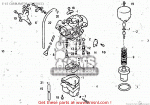Roadghost
Well-known member
I put one of these little filters on the end of the hose to keep the dirt out. Works really well.
10pcs 1/4" 6-7mm Motorcycle Scooter Hose Inline Gas Fuel Gasoline Filter New 691687197673 | eBay
10pcs 1/4" 6-7mm Motorcycle Scooter Hose Inline Gas Fuel Gasoline Filter New 691687197673 | eBay
















